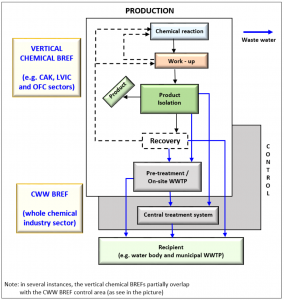Lesson 1 – Vertical vs. horizontal BREFs
Welcome to the lesson on Horizontal and Vertical BREFs! In this course, we will discuss the key concepts and principles related to BAT reference documents (BREFs), which were introduced as a result of the “Sevilla Process”. We will explore the differences between vertical and horizontal BREFs and their importance in reducing duplication of information while addressing sector-specific and cross-sectoral environmental issues.

Borderline between vertical and horizontal chemical BREFs
First, let’s define what we mean by vertical and horizontal BREFs. Vertical BREFs are sector-specific BREFs that cover one or more industrial activities listed in the annex to the IPPC Directive. These BREFs provide detailed guidance on best available techniques (BATs) for specific industrial sectors, with a focus on minimizing environmental impacts. Horizontal BREFs, on the other hand, address cross-sectoral issues such as industrial cooling systems, energy efficiency, and emissions from storage. These BREFs provide guidance on BATs that are relevant to multiple industrial sectors.
It is important to note that the BREFs are not static documents but are subject to continuous updates and revisions. A “ROM” (Results Oriented Monitoring) has been developed as a specific BREF document for monitoring air and water emissions from installations, under the Industrial Emissions Directive. The information contained in the BREFs is regularly reviewed and updated to reflect the latest BATs and technologies.
The BREFs full sets make up an information matrix, which reduces the quantity of duplication between them. In this context, it is essential to understand the distinctions between horizontal and vertical BREFs and how they complement each other. A vertical BREF takes precedence over a horizontal BREF because the information exchange has allowed the sector-specificities to be considered. When a relevant environmental issue is not specifically dealt with in a vertical BREF, the relevant horizontal BREF(s) applies. The same principle is valid in the BAT sections.
Since the vertical BREFs aim to minimize duplication with other reference documents, they usually do not repeat horizontal BAT. This prevents repetition and results in smaller BREF documents, which is strongly advocated by end-users.
In this course, we will explore various examples of horizontal and vertical BREFs and their significance in addressing environmental issues across different industrial sectors. We will also discuss the importance of complying with the guidelines provided in the BREFs to minimize environmental impacts and ensure sustainable industrial practices.
Thank you for joining our online course on Horizontal and Vertical BREFs. We hope this course provides you with a better understanding of the BREFs and their significance in promoting sustainable industrial practices.